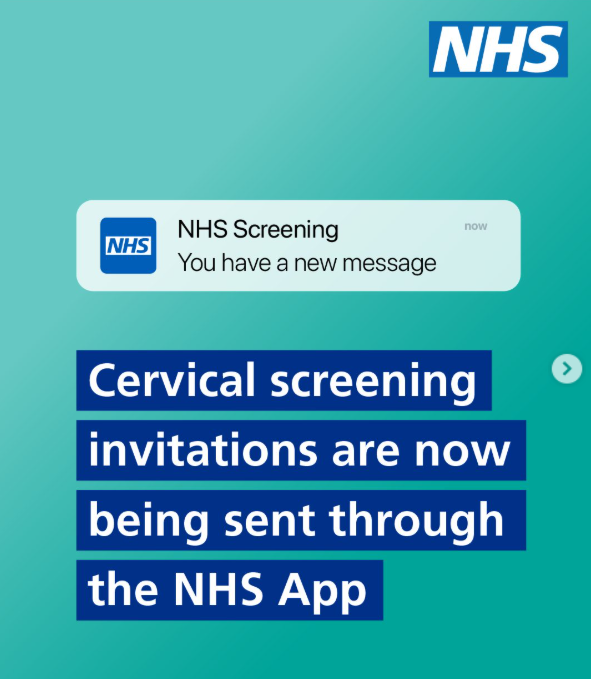What is Cervical Screening?
Cervical screening is a free health test available on the NHS as part of the national cervical screening programme. The test looks for early changes in the cells of the cervix. It helps prevent cervical cancer by checking for a virus called high-risk HPV and cervical cell changes. It is not a test for cancer.
It is your choice whether to go for cervical screening. We hope this information helps you make the best decision for you and your health.
If you have symptoms, contact your GP surgery about having an examination. Cervical screening is not for people who have symptoms.
Who is Invited for Cervical Screening?
You should be invited for cervical screening if you have a cervix. Patients who are registered as Female and people who have opted in to receive invitations should receive an invite every 5 years. An invitation letter will be sent when the cervical screening test is due, asking you to make an appointment. If you do not wish to receive invites/reminders, you can opt out: www.csas.nhs.uk/contact-us/screening-cease-info/screening-cease-nhspatient/
In the UK, you are automatically invited for cervical screening if you are:
- between the ages of 25 to 64
- registered as female with a GP surgery.
You may get your first invite up to 6 months before you turn 25. You can book an appointment as soon as you get the invite.
Supporting trans man or non-binary person with a cervix.
Registered with a GP as female
If you are aged 25 to 64 and registered with a GP as female, you will be routinely invited for cervical screening. We recommend that you consider having cervical screening if you have not had a total hysterectomy and still have a cervix.
Registered with a GP as male
If you are aged 25 to 64 and registered with a GP as male, you will not be automatically invited for cervical screening. However, if you have not had a total hysterectomy and still have a cervix, you should still consider having cervical screening. This is especially important if you have had any abnormal cervical screening results in the past.
If you want to ‘opt in’ to receive routine cervical screening invitations, you can contact a local cervical screening provider, for example your GP or practice nurse, sexual health clinic or transgender health clinic.
Trans women and non-binary people assigned male at birth
If you are a trans woman or non-binary person assigned male at birth, you will not need to be screened as you do not have a cervix.
Registered with a GP as female
If you are registered with a GP as female, you will be routinely invited for cervical screening unless your GP has already told us you’re not eligible. We can update our records so you are not invited unnecessarily.
Registered with a GP as male
If you are registered with a GP as male, you will not be invited for cervical screening.
For more information please visit Trans and non-binary cancer screening | Cancer Research UK. We have enabled booking online of these appointments. Please ensure that you are aged 25 or over. Smears are due every 5 years.
What are the Benefits of Cervical Screening?
- Cervical screening aims to identify whether you are at higher risk of developing cervical cell changes or cervical cancer. This means you can get any care or treatment you need early.
- England, Scotland and Wales now use HPV primary screening, which is even better as it is based on your individual risk. This means how frequently you are invited for cervical screening is based on your last result and within a timeframe that is safe for you.
Possible risks of cervical screening
- In a few cases, cervical screening will give an incorrect result. This means it may say someone does not have HPV or cell changes when they do (a false negative). Going for cervical screening when invited can help reduce this risk, as it is likely HPV or cell changes that were missed would be picked up by the next test. It also means a result may say someone does have HPV or cell changes when they don’t (a false positive), which could mean they are invited for tests or treatment they don’t need.
- Sometimes cell changes go back to normal without needing treatment. At the moment, we can’t tell which cell changes will go back to normal, so treating means we can be sure we are preventing them from developing into cervical cancer. This means some people may have unnecessary treatment, which is called overdiagnosis or overtreatment. Using HPV primary screening should help prevent this.
It is hard to know exactly how many people are affected by these risks. But we do know, for those aged 25 to 64, the benefits of cervical screening outweigh the risks and most results will be clear.

IMPORTANT UPDATE – Cervical Screening Results via NHS App –from 1st September 2025
From September 2025, some cervical screening results will be delivered digitally.
- – If your result is negative, you will receive it through the NHS App.
- – A notification will appear in your NHS App inbox.
- – If you don’t read the message within 72 hours, a letter will still be sent to you by post.
- – If your result is abnormal, you will continue to receive a letter by post.

